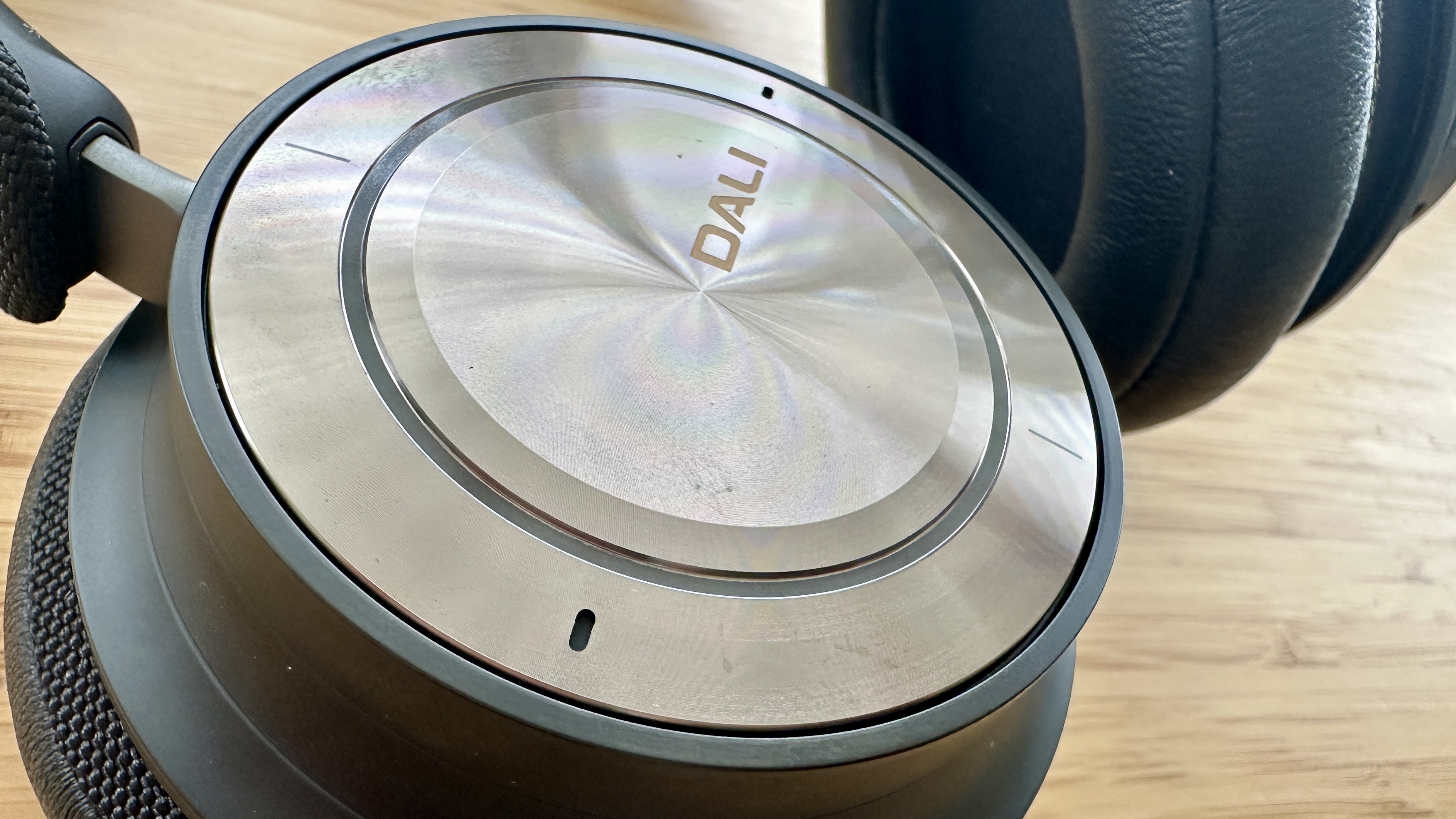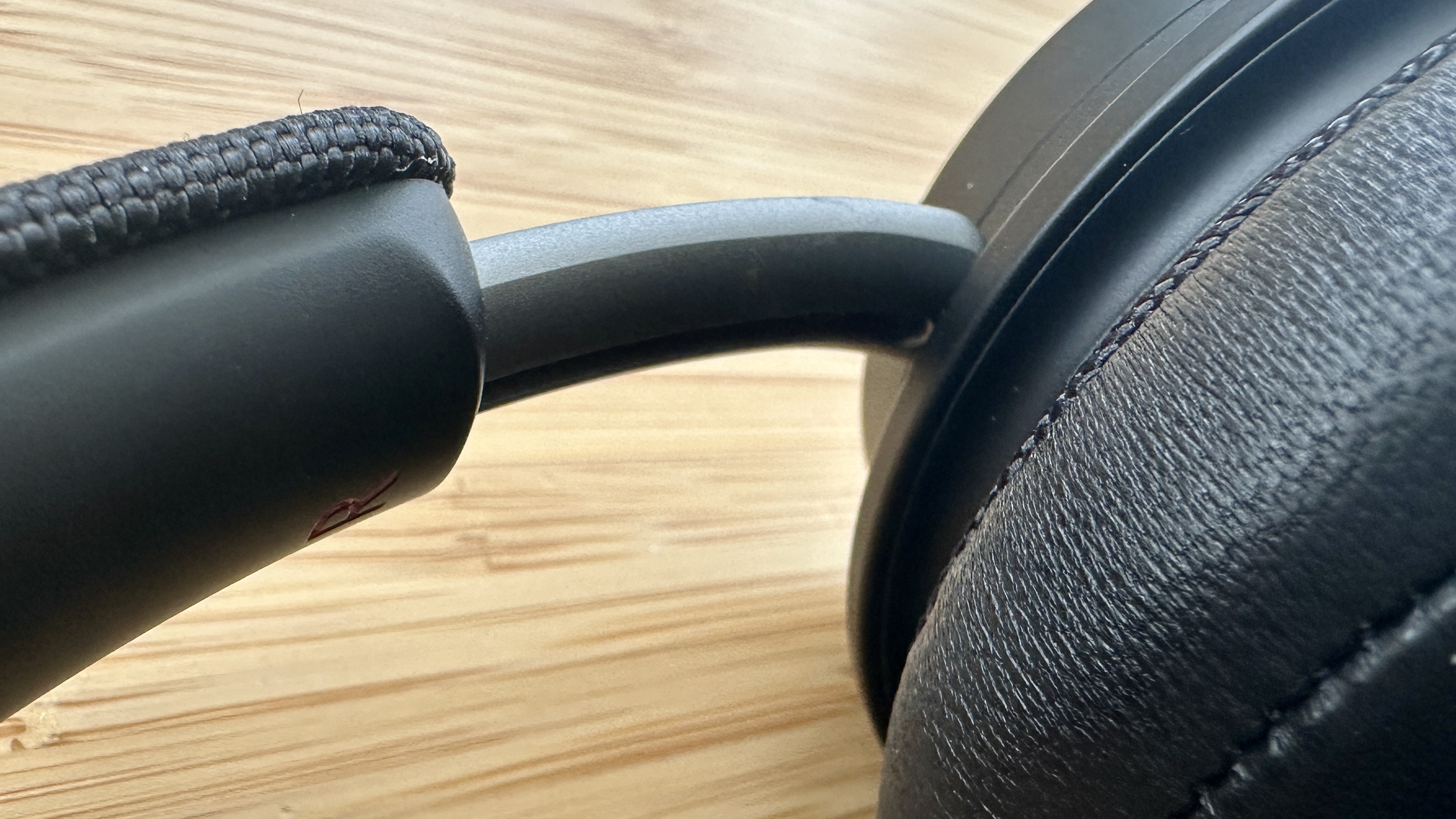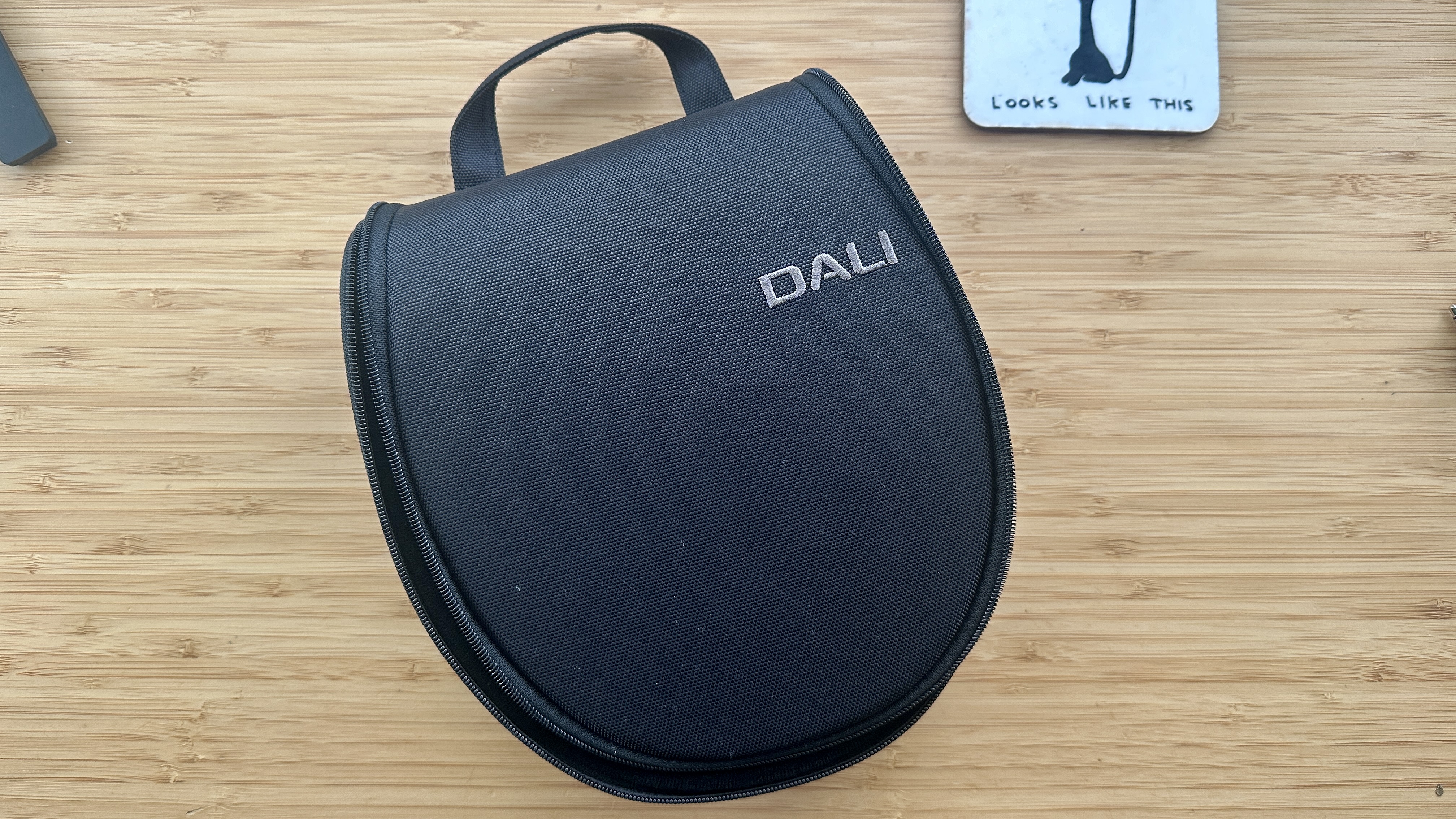TechRadar Verdict
The Dali IO-8's downsides are a) minor and b) nothing to do with the way they sound. Dali has challenged itself to create a competitive wireless headphone at a (relatively) real-world price and come up smiling…
Pros
- +
Positive, detailed and completely convincing sound
- +
Can happily function as hard-wired passive headphones, too
- +
Outstanding standard of build and finish
Cons
- -
No control app
- -
No vegan option
- -
Plenty of credible competition
Why you can trust TechRadar
Dali IO-8: Two-minute review
The Dali IO-8 are the wireless over-ear noise-cancelling result of the company's attempts to cater for more mainstream customers. A brand like Dali should have more than one pair of wireless over-ear noise-cancelling headphones in its line-up, of course, especially when the one pre-existing pair it does have costs pennies less than £1,000 in the UK. Yet, even at a price of £599, the aforementioned word ‘mainstream’ is perhaps not the first that should spring to mind for the new Dali IO-8.
With one fairly notable exception, the IO-8 are specified to compete at this fiercely contested price point for the best noise-cancelling headphones crown. They’re very acceptably built and finished, from high-quality materials (although the real leather isn’t going to excite vegan customers). Bluetooth 5.2 with aptX Adaptive compatibility, 30 hours of battery life with ANC engaged, 24bit/96kHz support, 50mm full-range drivers with 10Hz-43kHz frequency response… these are all welcome features. The ability to work passively, with no requirement for power, when wired via an analogue connection, is a very nice touch too.
Only the lack of a control app sounds a slightly bum note, no matter how Dali might seek to spin it as a virtue.

Dali IO-8 review: Price & release date
- Released on October 8, 2024
- Priced $899 / £599 / AU$TBC
The Dali IO-8 wireless over-ear noise-cancelling headphones launched on October 8, 2024, and in the United Kingdom they currently sell for £599. In the United States they’ll cost you $899, while in Australia the going rate has not officially been confirmed, at the time of publishing (but it'll be around AU$1,165 or thereabouts).
These are affordable wireless headphones by Dali standards, true, but everything’s relative, isn’t it? This sort of money can buy you some extremely well-regarded alternatives from brands that don’t necessarily consider $899 to be ‘entry-level’...

Dali IO-8 review: Specs
| Type | Over-ear |
| Weight | 325g |
| Drivers | 50mm free edge dynamic |
| Active noise cancellation | Yes |
| Battery life | 35 hours (ANC off); 30 hours (ANC on) |
| Control | Voice, touch |
| Connectivity | Bluetooth: 5.2 / SBC; AAC; aptX HD; aptX Adaptive |

Dali IO-8 review: Features
- 50mm free edge full-range dynamic drivers
- Bluetooth 5.2 with SBC, AAC, aptX HD and aptX Adaptive compatibility
- 35 hours of battery life
As far as the ‘wireless’ part of ‘wireless over-ear noise-cancelling headphones’ goes, the Dali IO-8 use Bluetooth 5.2 for connectivity, and have compatibility with SBC, AAC, aptX HD and aptX Adaptive codecs. But it’s also possible to use them via a wired connection – the USB-C socket on the right earcup can be used for data transfer as well as for charging the battery, and connected this way they’re able to deal with digital audio files of up to 24bit/96kHz resolution. Obviously you can give them even larger files to deal with, but these will be downscaled before the digital-to-analogue conversion takes place.
Dali provides a USB-C / USB-A cable in a reasonably compact travel case, and also includes a 3.5mm / 3.5mm analogue alternative. There’s a 3.5mm input on the left earcup, and if you make an analogue connection to a source player the Dali don’t even need to be powered on. Flat battery? No problem: the IO-8 can be used passively, which is a definite bonus.
Mind you, letting the battery run flat will smack of negligence. The Dali will run for 35 hours from a single charge with active noise-cancelling switched off, and if you switch it on that figure drops to a still-competitive 30 hours. The ANC itself (or ‘audiophile active noise-cancelling’, as Dali rather self-importantly has it) has ‘on’, ‘off’ and ‘transparency’ settings, and the company has tuned it for maximum sound quality rather than maximum noise-cancellation.

No matter how you get your audio information on board, it’s delivered to your ears by a couple of 50mm free edge full-range dynamic drivers that are good, suggests Dali, for a frequency response of 10Hz-43kHz. Just as it does with its full-size speakers, Dali has built these drivers from a paper fibre material with randomly aligned fibres of varying lengths to create a light-yet-stiff diaphragm with optimal damping.
As far as control is concerned, there are a couple of options here. Each earcup features a couple of mic openings – Dali has used cVc technology for telephony, and these mics also allow communication with your source player’s native voice assistant. In addition to its USB-C input, the right earcup features a combination of push- and touch-controls covering ‘play/pause’, ‘volume up/down’, ‘skip forwards/backwards’, ‘answer/end call’ and ‘power on/off/Bluetooth pairing’ as well as cycling through your ANC options or choosing between two EQ settings (‘hi-fi’ or ‘bass’).
What’s conspicuous by its absence, though, is a control app. Dali wants to make a virtue of this – it’s tuned the IO-8 to sound as good as they can, goes the rationale, and the last thing the sound quality needs is the end user sticking their oar in. Whether or not you think an outlay as significant as this ought to buy a swanky control app a la Bowers & Wilkins, Bose and all the rest of them is a question of personal preference.
- Features score: 4.5/5
Dali IO-8 review: Sound quality
- Detailed and expansive sound
- Positive, dynamic presentation
- Great low-end expression and agility
If you’ve heard any of Dali’s more expensive loudspeaker designs lately, the combination of talents the IO-8 demonstrate when playing music, of any type, won’t come as any kind of surprise. If you haven’t, though, well… it’s like this…
The IO-8 are remarkably insightful, detailed headphones. No element of a recording is too fleeting to elude them, and they have the happy knack of being able to put even the most transient events in a singular recording like Children Crying by The Congos into convincing context. Their remarkable facility for detail retrieval and expression is not at the expense of the bigger picture, either. The Dali create a large overall image, and it’s only when you peer closely at it that you realise just how alive with detail it is.
There’s a sensation of directness and of positivity to the way these headphones deliver music, a sensation of engagement that some similarly priced alternatives forgo in an effort to sound somehow more ‘accurate’. There’s no lack of precision to the IO-8, no lack of apparent fidelity – but they’re no dry tool of analysis. The idea of music as entertainment does not escape them, not even for a moment.
They have ample bite and shine at the top of the frequency range, but it’s controlled to the point that there’s never any glint of hardness, even in a Lee Perry production that is constantly on edge where treble sounds are concerned. The transition into the midrange is seamless, and once there the Dali communicate with absolute assurance and no little articulacy. They can relay a vocal performance's minutiae with the sort of effortlessness that makes for a direct and unequivocal listen.

At the bottom of the frequency range there’s a great combination of weight, texture and momentum. Listening with the ‘hi-fi’ EQ setting selected, the Dali offer straight-edged attack, rhythmic certainty, a decent amount of punch and an absolute stack of tonal and textural variation. Switch to ‘bass’ and while the amount of low-end presence increases noticeably, it’s not at the expense of any of the other work the Dali do with bass information. For my money it’s a slightly less naturalistic setting, but those who crave a bit of wallop won’t be disappointed.
Tonality is carefully neutral, and the frequency response is delightfully even from the very bottom of the frequency range to the very top. The broad dynamic shifts in intensity apparent in a 24bit/96kHz FLAC file of Stay Lit by Holy F*** are described in full – the IO-8 have no problem putting considerable distance between ‘loud’ and ‘quiet’. And the harmonic variations that are apparent in every instrument in this recording are given plenty of expression, too.
The Dali summon a large and persuasive soundstage, organizes it with utter authority and makes specific elements of even very complex recordings easy to identify and individualize. But at the same time it offers a very persuasive sensation of togetherness and singularity to recordings – there’s always an impression of ‘performance’ to the way it presents music.
Noise-cancelling, predictably, falls squarely into the ‘very good’ category rather than the very brief list headed ‘as good as Bose’ (single occupant: Bose). The IO-8 can do a reasonably thorough job on external sounds and keep those external distractions at bay, sure, but just as importantly, it does so without affecting the sonic characteristics in the slightest.
- Sound quality score: 5/5
Dali IO-8 review: Design
- ‘Iron’ black, or ‘caramel’ white finishes
- Real leather contact points
- Weighs 325g
It comes to something, doesn’t it, when ‘round’ counts as a design flourish? But the fundamental design of over-ear headphones is so established that the perfectly circular earcups and earpads of the IO-8 is about the only part of their appearance that’s even remotely unusual.
They’re expertly built and finished, mind you, and from very upmarket and tactile materials. The round plate that covers the outside of each round earcup is of brushed and anodised metal, while the contact points of the inside of the headband and the earpads themselves are of memory foam covered in genuine leather (so long, vegans, it was nice knowing you). An outer section of the earpads and the entirety of the outside of the headband are covered in hard-wearing textile.
The headband adjustment mechanism is mostly concealed inside the headband itself, and it moves with nicely judged resistance. At 325g the IO-8 are far from the heaviest wireless over-ears around, and both the hanger arrangement and clamping force are so judicious that they remain comfortable for hours at a time. And unlike quite a lot of rival products, the Dali are not so big that they exclude the smaller-headed among us.
- Design score: 4.5/5

Dali IO-8 review: Value
- High-quality sound at a crowded price point
- Comfortable, look good, excellent battery life
- No control app, plus non-vegan
You buy expensive headphones in order to enjoy high-quality sound, right? If so, then there’s no arguing with the value on offer here – the Dali IO-8 are by no means your only choice at the price, but they have nothing to apologize for when it comes to the way they sound.
And if you’re able to overlook the lack of a vegan option, the standard of build and finish is well up to standard, too. The IO-8 look and feel good and they’re comfortable for hours on end, with the battery life to prove it.
If you think this sort of money should buy a control app, you’ll certainly get no argument from me. But I have to wonder what it would be for – after all, the way Dali has voiced these headphones is unlikely to be improved by my fiddling with EQ settings, and the company has already indicated that the ANC is implemented to the maximum level it’s happy with. It would be nice to be able to integrate all my favorite music streaming services into one hub, of course, but I’ve seen enough ropey control apps to know that ‘no app’ is better than ‘annoying app’.
- Value score: 4.5/5
Should I buy Dali IO-8?
| Section | Notes | Score |
|---|---|---|
| Features | Bluetooth 5.2 connectivity, with SBC, AAC, aptX HD and aptX Adaptive codecs; 35-hour battery life | 4.5/5 |
| Sound quality | Detailed and expansive, with dynamic presentation and great low-end expresion | 5/5 |
| Design | Comes in two colorways; real leather contact points | 4.5/5 |
| Value | Great price in crowded market for high-quality sound; no control app | 4.5/5 |
Buy them if...
You like nice things
The look, feel and smell of the Dali IO-8 are well up to the sort of standard the asking price demands.
You enjoy direct, insightful sound
As is probably apparent by now, I am struggling quite hard to find any negative aspects to the way these headphones sound.
You’re not a conscientious charger
Allowed the battery to run flat? Again? No problem, the Dali IO-8 can operate as passive headphones, too.
Don't buy them if...
You’re vegan
Leather may be perceived as a luxurious material, and it has undoubted sonic benefits, but it’s hardly the most inclusive, is it?
You fancy yourself as a sound engineer
Dali has created two EQ settings for the IO-8, and the lack of a control app means you don’t get to stick your oar into the sound any further than choosing between them.

Dali IO-8 review: Also consider
| Dali IO-8 | Bowers & Wilkins PX8 | Apple AirPods Max | |
|---|---|---|---|
| Price | $899 / £599 / AU$xxx | $699 / £599 / AU$1,150 | $549 / £549 / AU$899 |
| Drivers | 50mm free edge dynamic | 40mm dynamic | 40mm dynamic |
| Active noise cancellation | Yes | Yes | Yes |
| Quoted battery life | 35 hours (ANC off); 30 hours (ANC on) | 30 hours | 20 hours |
| Weight | 0.71lb / 325g | 0.73 lb / 320g | 0.84 lb / 385g |
| Connectivity | Bluetooth 5.2 / SBC; AAC; aptX HD; aptX Adaptive | Bluetooth 5.2; aptX Adaptive; aptX HD | Bluetooth 5.0 |
| Frequency range | 10Hz - 43kHz | 10 Hz - 30 kHz | Not specified |
| Other features | USB-C / USB-A / 3.5mm ports, push- and touch-controls | Excellent B&W Music app, multi-room ecosystem | Digital Crown control from Apple Watch; Spatial Audio; Smart Case |
Bowers & Wilkins PX8
The most obvious IO-8 alternative are similarly pricey, similarly accomplished when it comes to performance (although their sound has a slightly different emphasis), and similarly upmarket in appearance. The ‘Music’ control app is a worthwhile point of difference, though, and the Px8 won’t suit the smaller-headed user quite so much either.
Here's our full Bowers & Wilkins PX8 review.
Apple AirPods Max
I’m contractually obliged to mention the Apple AirPods Max here. They’re a great option for iPhone and iPad users, to be fair, with a nicely realized sensation of spatial audio when connected to a sibling device, but I’ve yet to see anyone good-looking enough to wear them without looking like a bit of a ‘nana.
See our in-depth Apple AirPods Max review for more info.
How I tested the Dali IO-8
- Connected wirelessly, via USB-C and via 3.5mm analogue
- Powered and passively
- Indoors and out
They’re adaptable by the standards of wireless headphones, the Dali IO-8, and so I listened to them when wireless connected to an iPhone 14 Pro and a FiiO M15S digital audio player. I also listened to them via a USB-C connection to an Apple MacBook Pro (loaded with Colibri software in order to play authentically high-resolution content).
I also listened to them with the battery switched off and a hard analogue connection made to both the FiiO and the MacBook Pro, too. I listened to them at my desk and on public transport, I listened to lots of different styles of music, delivered via lots of different digital audio file types and sizes. And I did all of this, on and off, for well over a week.
- First reviewed: October 2024
- Read more about how we test
Simon Lucas is a senior editorial professional with deep experience of print/digital publishing and the consumer electronics landscape. Based in Brighton, Simon worked at TechRadar's sister site What HiFi? for a number of years, as both a features editor and a digital editor, before embarking on a career in freelance consultancy, content creation, and journalism for some of the biggest brands and publications in the world.
With enormous expertise in all things home entertainment, Simon reviews everything from turntables to soundbars for TechRadar, and also likes to dip his toes into longform features and buying guides. His bylines include GQ, The Guardian, Hi-Fi+, Metro, The Observer, Pocket Lint, Shortlist, Stuff T3, Tom's Guide, Trusted Reviews, and more.

